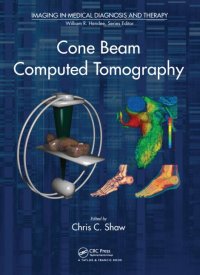
Ebook: Cone Beam Computed Tomography
Author: Chris C. Shaw (ed.)
- Tags: Tomography, HEALTH & FITNESS -- Diseases -- General, MEDICAL -- Clinical Medicine, MEDICAL -- Diseases, MEDICAL -- Evidence-Based Medicine, MEDICAL -- Internal Medicine, Cone-Beam Computed Tomography
- Series: Imaging in Medical Diagnosis and Therapy
- Year: 2014
- Publisher: CRC Press
- Language: English
- pdf
The first text to focus solely on quality and safety in radiotherapy, this work encompasses not only traditional, more technically oriented, quality assurance activities, but also general approaches of quality and safety. It includes contributions from experts both inside and outside the field to present a global view. The task of assuring quality is no longer viewed solely as a technical, equipment-dependent endeavor. Instead, it is now recognized as depending on both the processes and the people delivering the service. Recently, a transformation of quality and safety in radiotherapy has begun to take place. Among the key drivers of this transformation have been new industrial and systems engineering approaches that have come to the forefront in recent years following revelations of system failures. This book provides an approach to quality that is long needed, one that deals with both human and technical aspects that must be the part of any overall quality improvement program.
The first text to focus solely on quality and safety in radiotherapy, this work encompasses not only traditional, more technically oriented, quality assurance activities, but also general approaches of quality and safety. It includes contributions from experts both inside and outside the field to present a global view. The task of assuring quality is no longer viewed solely as a technical, equipment-dependent endeavor. Instead, it is now recognized as depending on both the processes and the people delivering the service. Divided into seven broad categories, the text covers:
- Quality Management and Improvement includes discussions about lean thinking, process control, and access to services.
- Patient Safety and Managing Error looks at reactive and prospective error management techniques.
- Methods to Assure and Improve Quality deals broadly with techniques to monitor, assure, and improve quality.
- People and Quality focuses on human factors, changing roles, staffing, and training.
- Quality Assurance in Radiotherapy addresses the general issues of quality assurance with descriptions of the key systems used to plan and treat patients and includes specific recommendations on the types and frequencies of certain tests.
- Quality Control: Equipment and Quality Control: Patient-Specific provides explicit details of quality control relating to equipment and patient-specific issues.
Recently, a transformation of quality and safety in radiotherapy has begun to take place. Among the key drivers of this transformation have been new industrial and systems engineering approaches that have come to the forefront in recent years following revelations of system failures. This book provides an approach to quality that is long needed, one that deals with both human and technical aspects that must be the part of any overall quality improvement program.